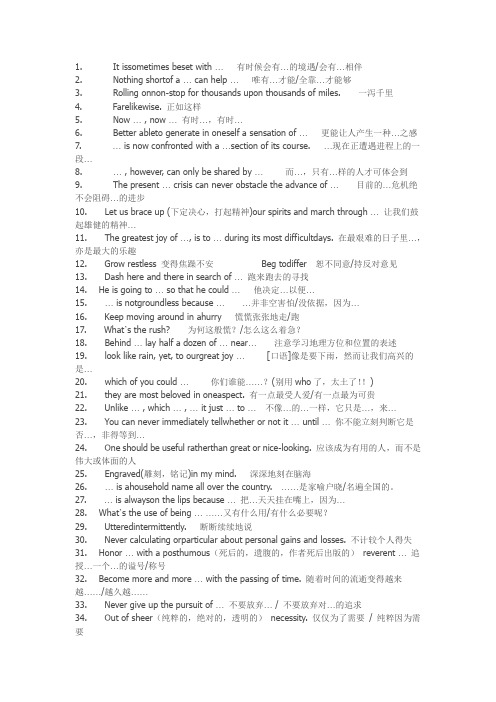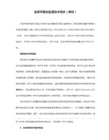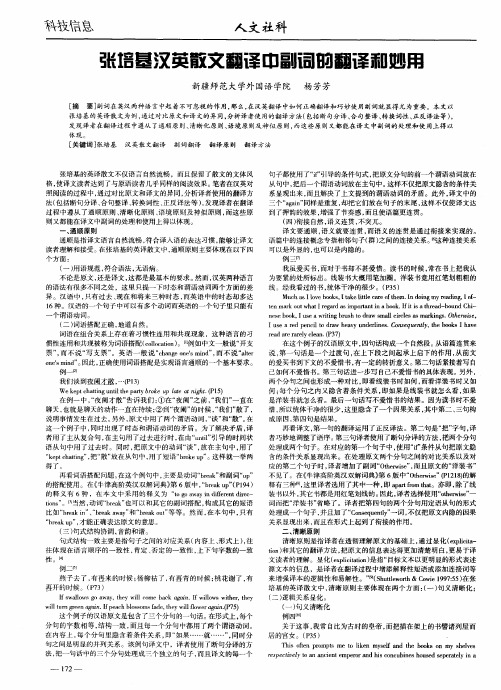张培基翻译用法总结
- 格式:doc
- 大小:18.00 KB
- 文档页数:5

1. It issometimes beset with …有时候会有…的境遇/会有…相伴2. Nothing shortof a … can help …唯有…才能/全靠…才能够3. Rolling onnon-stop for thousands upon thousands of miles. 一泻千里4. Farelikewise. 正如这样5. Now … , now …有时…,有时…6. Better ableto generate in oneself a sensation of …更能让人产生一种…之感7. … is now confronted with a …section of its course. …现在正遭遇进程上的一段…8. … , however, can only be shared by …而…,只有…样的人才可体会到9. The present … crisis can never obstacle the advance of …目前的…危机绝不会阻碍…的进步10. Let us brace up (下定决心,打起精神)our spirits and march through …让我们鼓起雄健的精神…11. The greatest joy of …, is to … during its most difficultdays. 在最艰难的日子里…,亦是最大的乐趣12. Grow restless 变得焦躁不安Beg todiffer 恕不同意/持反对意见13. Dash here and there in search of …跑来跑去的寻找14.He is going to … so that he could …他决定…以便…15. … is notgroundless because ……并非空害怕/没依据,因为…16. Keep moving around in ahurry 慌慌张张地走/跑17. What’s the rush? 为何这般慌?/怎么这么着急?18. Behind … lay half a dozen of … near…注意学习地理方位和位置的表述19. look like rain, yet, to ourgreat joy …[口语]像是要下雨,然而让我们高兴的是…20. which of you could …你们谁能……?(别用who了,太土了!!)21. they are most beloved in oneaspect. 有一点最受人爱/有一点最为可贵22. Unlike … , which … , … it just … to …不像…的…一样,它只是…,来…23. You can never immediately tellwhether or not it … until …你不能立刻判断它是否…,非得等到…24. One should be useful ratherthan great or nice-looking. 应该成为有用的人,而不是伟大或体面的人25. Engraved(雕刻,铭记)in my mind. 深深地刻在脑海26. … is ahousehold name all over the country. ……是家喻户晓/名遍全国的。

英汉翻译教程张培基【完整版】《英汉翻译教程》第一章总论翻译是运用一种语言把另一种语言所表达的思维内容准确完整地重新表达出来的语言活动。
(张培基等1983)我国早期典籍《周礼·秋官司寇》篇里就有―象胥‖(谓通言语之官)这一名目,唐朝贾公彦所作的《义疏》里提到―译即易,谓换易言语使相解也。
‖这条注疏,关于翻译的定义,足以给人不少启发。
用现代文艺理论和语言理论,也许可以诠释为:翻译是把一种语言文字换易成另一种语言文字,而并不变更所蕴含的意义,——或用近年流行的术语说,并不变更所传递的信息,——以达到彼此沟通,互相了解的目的。
(罗新璋1984)一、关于翻译何谓翻译?关于翻译的定义很多。
根据《现代汉语词典》,翻译是―把一种语言文字的意义用另一种语言文字表达出来‖。
根据《剑桥语言百科全书》,―翻译‖这个中性术语是指将一种语言(―原语‖)里的词句的意思转变为另一种语言(―目的语‖)的意思所做的一切,不论其手段是说话、写字还是做手势。
美国著名翻译理论家奈达认为,所谓翻译,是指从语义到语体在译语中用最切近而又最自然的对等语再现原语的信息。
(《奈达论翻译》,1984)有人把翻译看作是一门科学(science),因为它有自身的规律可循;有人看作是一门艺术(art),因为它是译者对原文再创造的过程;也有人看作是一门手艺(craft),因为原语的信息需要用地道恰当的目的语再现。
在自动化数据处理中,翻译又被定义为:―将计算机信息从一种语言转换成另一种语言,或将字符从一种表示转换成另一种表示。
‖(《现代科学技术词典》上海科学技术出版社1980)凡此种种,不一而足。
但是,在经济和文化日益全球化的今天,翻译的重要性是有目共睹的。
翻译是国际间理解的钥匙,据说西欧的文明归功于翻译者(据L·G·凯里1979)。
季羡林教授也说,翻译是永葆中华文明青春的万应灵药。
前中国驻联合国代表凌青先生说,从中国来讲,没有翻译工作,就没有中国***和中国近代的革命运动,就没有中国成功的对外开放和四个现代化;从世界范围来讲,没有翻译,就没有世界和平,就没有各种国际交往,就没有一个共同繁荣的美好世界的未来。


浅析张培基散文翻译选【篇一:浅析张培基散文翻译选】2012.6 上半月 \ 翻译原则语用策略写作理论及其它陈姝彤何泠静等浅析张培基先生英译散文作品中的翻译原则陈姝彤摘要: 形散而神不散是散文的特点,作为一种特殊的文体,散文在翻译过程中,要求内容与风格并重。
张培基先生在翻译散文时,灵活巧妙地运用翻译技巧,不仅译其形而且传其神。
本文试图三个散文翻译的原则探讨张培基先生是如何在翻译散文中成功实现风格和韵味的移植的。
关键词:张培基;散文翻译;翻译原则一、简介随着文学概念的演变和文学体裁的发展,散文的概念也时有变化。
广义的散文诗区别于韵文、骈文的,包含所有不押韵不排偶的散体文章。
可某些历史时期又将小说与其他抒情、记事的文学作品统称为散文,以此来区别于讲求韵律的诗歌。
狭义的散文指除了小说、诗歌、戏剧等文学体裁之外的其他文学作品。
如今,现代意义的散文把除诗歌以外的文体都成为散文。
二、散文的特征1、散文的真散文的真首先是在语言表达上,不假雕饰、开门见山、直奔主题、全凭本色的真实和直接。
它不像诗歌那样含蓄,不用讲究语言的韵律感、意象和象征等修辞手法,也不用像小说、戏剧一样讲究语言技巧。
散文的真还体现在感情上,无论是抒情散文还是叙事散文,都有真情的渗入,蕴含动人的力量。
有人曾说:散文是最接近人类表达自己的一种形式。
2、散文的散提起散文,总会想起一句话:形散而神不散。
散文的散,从表层来看,主要体现在散文的选材范围无拘无束,表现的形式自由开放。
在选材方面,一切都可以成为散文的写作内容;从形式上看,对于结构、韵律没有规范的要求,可以叙事、抒情、说理,一切放任自由。
3、散文的美认为普遍认为散文也可被称为美文。
它的美主要体现在韵味和意境上。
散文的语言质朴、平实、流畅、自然,但是一旦经过感情的渗透就可以在平淡中显现出品位。
有这样一种比较:如果说诗歌是陌生化的语言,散文则是平民化的语言。
(胡显耀、李力,2009:178)三、散文翻译的原则散文的翻译,顾名思义,就是将散文翻译成不同文字的文本。

张培基英译散文选笔记详解在学习英语的道路上,我像个好奇的探险家,不断寻找着宝藏。
而张培基先生的英译散文选,就像是我发现的一座神秘宝库,里面装满了闪闪发光的知识宝石。
为了能深入挖掘这座宝库,我认认真真地做起了笔记。
这可不是简单的勾勾画画,而是一场与文字的亲密对话。
翻开那本厚厚的英译散文选,每一篇文章都像是一个全新的世界。
我就像个初次踏入陌生国度的旅行者,既兴奋又有些小心翼翼。
比如说,有一篇描写春天的散文。
原文里那一句“春风拂过,大地复苏”,张培基先生翻译成了“With the gentle breeze blowing, the land comes back to life.” 我在笔记里详细地写下了自己的思考:“春风”没有直译成“spring wind”,而是用了“gentle breeze”,多了一份轻柔的感觉。
“拂过”用“blowing”,简洁又生动。
“大地复苏”处理成“comes back to life”,让整个句子充满了活力。
我还特意在旁边画了个大大的感叹号,提醒自己这个巧妙的翻译。
又比如,遇到一个复杂的长句子,我会像拆解谜题一样,一点点分析。
把句子的结构、语法、词汇用法都详细记录下来。
有时候一个句子能写上满满一页纸的笔记,各种箭头、标注,乱中有序,那都是我思考的痕迹。
还记得有一次,看到一个关于古老建筑的描写。
原文形容那些建筑“历经风雨,依然屹立不倒”,张培基先生翻译为“Having weathered numerous storms, the ancient buildings still stand firm.” 我当时就被这个翻译惊艳到了。
“weather”这个词用得太妙了,本来是“天气”的意思,在这里用作动词,形象地表达出了建筑经受风雨洗礼的过程。
我赶紧在笔记里写下自己的感悟,还找了几个类似的例子,加深对这种用法的理解。
做笔记的过程中,我也闹过不少笑话。
有一回,我太着急把一个单词的意思记错了,结果在复习的时候怎么都想不通,自己还跟自己生闷气,怪自己太粗心。

张培基《英译中国现代散文选》中修辞手法的翻译策略研究英译中国现代散文选是张培基的一部经典著作。
文中阐述了英翻中的一些关键策略,并且在涉及到修辞手法的翻译上,提出了诸多有效的翻译方法。
首先,张培基提到了修辞手法对翻译影响。
中国现代散文选中,大量修辞手法被用来加强文字的表达效果,这些修辞手法在英文中未必能得到完美的体现。
因此,翻译时,译者要力求完整地保留原文的修辞效果,以减少原文的形式和内容上的差异。
其次,张培基也强调在修辞手法的翻译过程中,要做到多事、多方,即既要充分表达原作意涵,又要尊重原作特色。
只有结合当时的情景等背景信息,在保留原作风格和氛围的同时,才能增加英文译文词汇和表达方式的多样性。
此外,为了实现更好的效果,张培基强调翻译者多熟悉一段时期的原文精神,弄清一种文字所具有的特定风格,以及该风格下修辞手法的施用方法和律动。
只有熟悉这些,才可以在完全表达原文韵律和修辞效果的同时,进行更自然的翻译,更好地表现中国的美学特色。
最后,张培基提出,翻译时对修辞手法的把握要体现和表达原文的情调,积极把握一定的修辞效果,以使英文译文更加得体、雅致,凝练、质朴。
总而言之,英译中文现代散文要求翻译者无论在表达方面还是语言工具方面,都具有非凡的天赋和高超的技能,使得英文译文精妙绝伦,信达雅。
张培基提出的修辞手法的翻译策略,不仅丰富了翻译的技巧,也为英译中文现代散文的翻译发展提供了可贵的启示。
Zhang Peiji's English Translation of Chinese Modern Prose Selections is a classic work. The book discloses some key strategies for English translation into Chinese, and also provides numerous effective methods for the translation of rhetorical techniques.Firstly, Zhang Peiji pointed out the influence of rhetorical techniques on translation. In Chinese Modern Prose Selections, numerous rhetorical techniques are used to improve the expressiveness of the words, which may not be perfectly expressed in English. Therefore, when translating, the translator should try to preserve the original rhetorical effect completely to reduce the difference in form and content of the original text.Secondly, Zhang Peiji also emphasized the need to be versatile and multi-talented when translating rhetorical techniques, that is, to fully express the original intention of the work and respect its characteristics. Only by combining the background information such as the original context, can the diversity of English vocabulary and expression be increased while retaining the style and atmosphere of the original work.In addition, in order to achieve better results, Zhang Peiji stressed that the translator should be familiar with the spirit of the original text during a certain period, understand the specific style of a text and the method and rhythm of using rhetorical techniques in this style. Only in this way can the original literary rhythm and rhetorical effects be fully expressed while the translator can perform a more natural translation and better demonstrate the aesthetic characteristics of China.Finally, Zhang Peiji suggested that when translating, the grasp of rhetorical techniques should reflect and express the mood of the original text, grasp certain rhetorical effects actively, so as to make English translation more decent, elegant, concise and unadorned.In conclusion, English translation of Chinese modern prose requires the translator to have extraordinary talents and superb skills both in expression and language tool, so that the English translation can be exquisite and tasteful. The translation strategies of rhetorical techniques proposed by Zhang Peiji not only enrich the translation skills, but also provide valuable inspiration for the development of English translation of Chinese modern prose.。
It is sometimes beset with …有时候会有…的境遇/会有…相伴 Nothing short of a … can help …唯有…才能/全靠…才能够Rolling on non-stop for thousands upon thousands of miles. 一泻千里Fare likewise. 正如这样Now … , now …有时…,有时…Better able to generate in oneself a sensation of …更能让人产生一种…之感…is now confronted with a …section of its course. …现在正遭遇进程上的一段…… , however, can only be shared by …而…,只有…样的人才可体会到The present … crisis can never obstacle the advance of …目前的…危机绝不会阻碍…的进步Let us brace up our spirits and march through …让我们鼓起雄健的精神…The greatest joy of …, is to … during its most difficult days. 在最艰难的日子里…,亦是最大的乐趣Grow restless 变得焦躁不安 Beg to differ 恕不同意/持反对意见Dash here and there in search of …跑来跑去的寻找He is going to … so that he could …他决定…以便…… is not groundless because ……并非空害怕/没依据,因为…Keep moving around in a hurry 慌慌张张地走/跑What’s the rush? 为何这般慌?/怎么这么着急?Behind … lay half a dozen of … near …注意学习地理方位和位置的表述look like rain, yet, to our great joy … [口语]像是要下雨,然而让我们高兴的是…which of you could …你们谁能……?(别用who了,太土了!!)they are most beloved in one aspect. 有一点最受人爱/有一点最为可贵Unlike … , which … , … it just … to …不像…的…一样,它只是…,来…You can never immediately tell whether or not it … until …你不能立刻判断它是否…,非得等到…One should be useful rather than great or nice-looking. 应该成为有用的人,而不是伟大或体面的人Engraved in my mind. 深深地刻在脑海… is a household name all over the country. ……是家喻户晓/名遍全国的。
翻译理论知识《翻译理论与实践》考试理论部分复习提纲一、翻译定义:1. 张培基——翻译是用一种语言把另一种语言所表达的思维内容准确而完整地重新表达出来的语言活动。
3. 刘宓庆——翻译的实质是语际的意义转换。
4. 王克非——翻译是将一种语言文字所蕴含的意思用另一种语言文字表达出来的文化活动。
5. 泰特勒——好的翻译应该是把原作的长处完全地移注到另一种语言,以使译入语所属国家的本地人能明白地领悟、强烈地感受,如同使用原作语言的人所领悟、所感受的一样。
6. 费道罗夫——翻译就是用一种语言把另一种语言在内容与形式不可分割的统一中所业已表达出来的东西准确而完全地表达出来。
7. 卡特福德-- 翻译的定义也可以这样说:把一种语言(Source Language)中的篇章材料用另一种语言(Target Language)中的篇章材料来加以代替。
8. 奈达——翻译就是在译入语中再现与原语信息最切近的自然对等物,首先就意义而言,其次就是文体而言。
“ Translating consists in reproducing in the receptor language the closest natural equivalent of the source language message, first in terms of meaning and secondly in terms of style.” ---Eugene Nida纽马克——通常(虽然不能说总是如此),翻译就是把一个文本的意义按作者所想的方式移译入另一种文字(语言)。
“ Translation is a craft consisting in the attempt to replace a written message and/or statement in one language by the same message and/or statement in another language”. --- Peter Newmark10. “ Translation is the expression in one language (ortarget language 译入语) of what has been expressed in another language (source language 原语), preserving semantic and stylistic equivalences.” --- Dubois12. 13.Translation or translating is a communicative activity or dynamic process in which the translator makes great effort to thoroughly comprehend a written message or text in the source language and works very hard to achieve an adequate or an almost identical reproduction in the target language version of the written source language message or text.二、翻译标准1. 翻译的标准概括为言简意赅的四个字:“忠实(faithfulness)、通顺(smoothnesS”忠实指的是忠实于原文。
张培基翻译用法总结
在做翻译的过程中,总结了一下张培基书中的一些用法,主要是词汇,也有句型,当然只是部分篇章的,希望对大家有用。
一定要回贴啊!!!不知怎么附件上来,直接贴了。
Be beset with difficulties: 被所困扰,包围
Nothing short of : only
Surmount: 克服
A mighty long river
Fare likewise: 过活,遭遇,进展相同
Now..now..:有时
Be confronted with: 遭遇面临
Brace up our spirits: 打起精神,下定决心
Grow restless:不安
Help sb out:帮助解决困难
Exhilarate:使活跃,高兴,兴奋
Take after: 向学习
Be engraved in one’s mind: 铭刻心中
A household name
Be on the lips of sb
Weak in memory and sloppy in thinking: 草率,粗心,邋遢With a grin:
On urgent business:有急事
What with…and (what with)…一方面由于,另一方面由于,半因
Breathe one’s last: pass away
Pet phrase: 口头禅
Lazybone:
Personal gains and losses: 个人得失
Innumerable:无数大量in large quantities, bountiful Spread far and wide: 广传
Out of sheer necessity: 出于需要,不得已
Follow one’s own bent (inclination): 平爱好兴趣办事Be in the prime of life:盛年年富力强
A special field of study:一种专门学问
Youth should be gone never to return: 一去不复返
Do sb a good turn: 于。
有益不辜负
Make a living /earn one’s bread
Set one’s mind on 致力于
Time is no object.时间不是问题
Through the ages 古往今来
Eat into
From cover to cover
By dint of
At one sitting
Obsession with
Subject to
Slip into the old rut
Needless to say
Social intercourse 社交
Have little in common with
Give little thought to
As it were 似乎可以说是
Have good reason to 有理由干什么Worthy of remembrance 值得回忆Bygone days
In the habit of 习惯做。
Unwittingly 不知不觉的
Reparable loss 可修复的损失
Ward off starvation 避开(坏事危险)As a last resort
On reflection 想一想
Bedding 铺盖
Be reduced to
Beneath oneself to do
Invariably 总是一直
It stands to reason that。
是合乎情理的Care to 喜欢愿意
Fish for help寻找帮助
Generate in me a feeling
Personal connections
Beyond one’s capacity to do
Solicit help 寻求帮助resort to turn to sb for help Disdain to do
Go here and there =go about
So and so =such and such
Kill my idea of 打消念头
Let alone=
Divorce from :分离
Urge to do:有强烈欲望
For good(and all): 永久一劳永逸
Violate taboo:
For one’s part: 至于某人来说,对而言Dissuade sb from doing: 说服不要做
Refrain from doing:忍住,抑制住做。
Set one’s mind at rest:使某人安心
It is more than 2 years since I last saw my father Misfortunes never come singly
Heaven always leaves one a way out.
Between …and …: 由于什么的共同作用
Urge sb to do
After some wavering:经过一些犹豫动摇
Talk sb out of sth: 打消某人想法,劝阻不要做Smart aleck: 自作聪明,自以为是的人smarty。